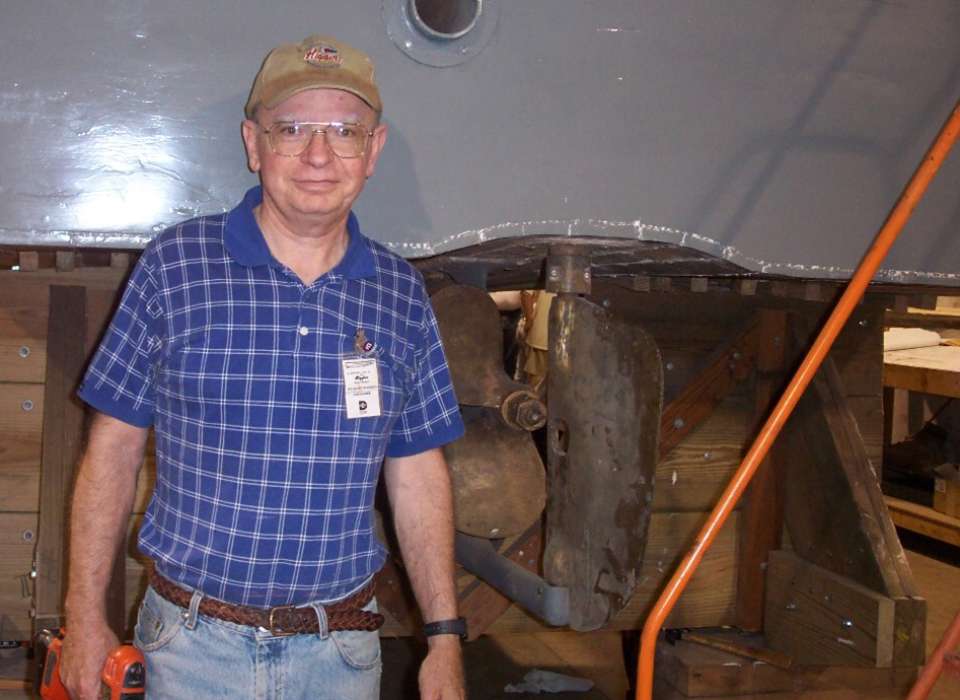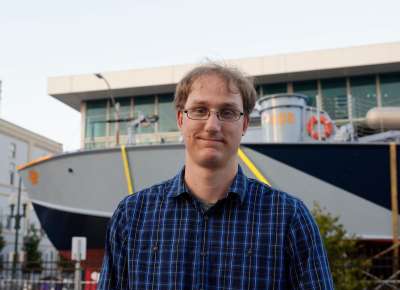In celebrating the 20th Anniversary of The National World War II Museum’s opening we are taking time to look back at the many volunteers who have helped make the Museum what it is today. One of the longest-serving volunteers was a man named Richard M. Warren. Better known as “Doc,” he worked with all three Higgins boat restoration projects until his passing in June 2015. Doc was a close friend of mine, and I looked forward to every day that we worked together on the various Higgins restoration projects. His passion and dedication to history and the mission of the Museum was typical of our many volunteers, but Doc had his own way of going about it.
Richard Warren was born during World War II in Worchester, Massachusetts. In 1965, he graduated from the College of the Holy Cross with a B.S. in Biology before completing his residency at St. Elizabeth’s Hospital in Boston, Massachusetts. Completing a fellowship in neurology and electroencephalography at the University of Minnesota, Doc joined the US Navy in 1967. He served for twelve years, attaining the rank of Lieutenant Commander, before returning to civilian life. Doc served on various boards, teaching positions, and hospitals before he ended up in Louisiana where he made his home and life. This is where he began working on the Higgins restoration projects.
Doc’s impact on the group was immediate. He fit right into the crew, even if he did things in his specific way. Doc operated in his own little world. This was not some sort of “La-la land,” Doc worked with such precision and passion that he would let little else bother him while he was focused. Among the boat volunteers his meticulous nature was legendary. One time I was tasked with reinstalling the port holes on PT-305. They had been removed so the hull in the area could be replaced. When I retrieved the original portholes from the storage racks I asked Doc if he had taken measurements between the ribs when he removed them. Doc produced a piece of paper with his clear, but crazy, hand writing detailing their original location. I happily accepted the note and proceeded into the crew’s quarters with another volunteer. It was not until we got to the location of the porthole did we realize that Doc had recorded the exact location in CENETEMETERS, a level of precision necessary in in neurology but no a requirement in boat restoration wood work.
Perhaps the best way to sum up Doc at work is a story that volunteers who were there will always remember fondly. When we were working on the LCPL, Doc was tasked with building and installing spray rails on the boat’s hull. These are small strips of wood that attach to the underside of the hull, directing water and spray in a way that improves efficiency. In order to get the pieces to conform to the hull of the boat they needed to be cut to exacting standards, something Doc excelled at, then they needed to be steamed for a few hours to make them pliable enough to bend with the curvature of the hull. We did not have a steam box so Doc built one and got to steaming. Being propelled by sheer problem-solving logic, Doc built an insulated box with a hinged opening. Next, he needed some steam so he took an old metal container, cleaned it out, filled it with water, put it over a burner, and started piping steam into his box. It is important to note two things: First our restoration warehouse used to be directly across the street from the Museum’s main entrance where hundreds of people were coming and going. Second, and probably most importantly, Doc had used an old metal gas can for his boiler. So now, everyone walking in for a visit to the Museum would look across the street and see a man, casually going about his business, standing next to a red gas can with a fire under it. Needless to say, the expressions of panic on peoples’ faces as Doc stood next to a gas can that most expected to explode at any moment has kept us laughing for over a decade. The steaming went perfectly, the pieces fit, and much later we explained to Doc why everyone looked so panicked.
This is the panic inducing steaming rig that Doc created while working on the LCP(L). It is in full operation in this photograph, set up just outside the museum entrance. The roar of the propane burning really added to the drama.
Over the course of the restoration projects Doc would often be given the most meticulous tasks. There was little he could not contribute to. Complicated wood glue-ups, bulkhead installations, blueprint organization, and his masterpiece—organization of thousands of pre-restoration hull survey photographs. Beyond enjoying these complex tasks, Doc was dedicated. In 2005, Hurricane Katrina came to the Gulf South and wreaked havoc. Doc lost his home, and nearly everything in it. At the time the Museum boat volunteers were between projects. We had completed restoring the LCPL in 2004 and were looking for our next project – a Higgins Patrol Torpedo boat. We did not quite have a boat hull yet, but that did not stop the volunteers from doing the planning that would allow such a large project to begin. This involved getting copies of hundreds of original Higgins blueprints from a local special collection. Doc was in the process of organizing these copied prints when the storm hit. When he and his wife evacuated, Doc filled the valuable space in one of their cars with the blueprints for a Higgins PT boat. He could have taken more from his house, but he chose these prints so they would not be lost.
Loosing Doc in 2015 was hard, especially two years before the restoration work on PT-305 would be completed. He was an amazing and passionate volunteer whose hard work and dedication to the mission of The National World War II Museum will always be remembered.


